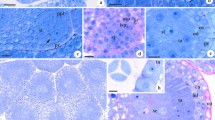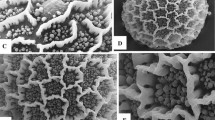Abstract
Dioecy has evolved independently several times in the large, mostly tropical genusSolanum. In all cases of dioecy inSolanum functionally male flowers have normal anthers, normal pollen and reduced stigmas while functionally female flowers have stigmas and anthers that appear normal but contain non-functional, usually inaperturate pollen. The inaperturate pollen has living cytoplasm, but apparently never germinates and it has been hypothesised that the pollen in these functionally female flowers is retained as a pollinator reward. Pollen morphology is compared in twelve of the thirteen known dioecious species ofSolanum, and some stages in the the development of inaperturate pollen in the anthers of functionally female flowers ofSolanum confertiseriatum of Western Ecuador are examined. Observations on the development and morphology of inaperturate pollen in functionally female flowers ofSolanum are related to hypotheses about the evolution of dioecy in the genus.
Similar content being viewed by others
References
Anderson, G. J., 1977: The variation and evolution ofSolanum sectionBasarthrum. II. — Brittonia29: 116–128.
—, 1979: DioeciousSolanum species of hermaphroditic origin is an example of broad convergence. — Nature282: 836–838.
—, 1982: Three taxa constitute the sexes of a single species of dioeciousSolanum. — Taxon81: 667–672.
—, 1989: Functional dioecy and andromonoecy inSolanum. — Evolution43: 204–219.
Baker, H., 1959: Reproductive methods as factors in speciation in flowering plants. — Cold Spring Harbor Symp. Quant. Biol.24: 177–191.
Baker, H. G., 1976: “Mistake” pollination as a reproductive system with special reference to the Caricaceae. — InBurley, J., Styles, B. T., (Eds): Tropical trees: variation, breeding and conservation, pp. 161–169. — London: Academic Press.
Bawa, J. S., 1980: Evolution of dioecy in flowering plants. — Annual Rev. Ecol. Syst.11: 15–39.
—, 1994: Pollination of tropical dioecious angiosperms: a reassessment? No, not yet. — Amer. J. Bot.81: 456–460.
Bawa, K. S., Beach, J. H., 1981: Evolution of sexual systems in flowering plants. — Ann. Missouri Bot. Gard.68: 254–274.
—, 1975: Dioecism in tropical forest trees. — Evolution29: 167–179.
Beach, J. H., Bawa, K. S., 1980: Role of pollinators in the evolution of dioecy from distyly. — Evolution34: 1138–1142.
Bitter, G., 1913: LXXVII. Solana nova vel minus cognita. VII. XVII. Solana diversa. — Repert. Spec. Nov. Regni Veg.11: 481–491.
Blackmore, S., 1990: Sporoderm homologies and morphogenesis in land plants, with a discussion ofEchinops sphaerocephala (Compositae). — Pl. Syst. Evol., Suppl.5: 1–12.
—, 1990: Angiosperm pollen wall ontogeny. — InBlackmore, S., Knox, R. B., (Eds): Microsporogenesis: ontogeny and evolution, pp. 173–192. — London: Academic Press.
McConchie, C. A., Knox, R. B., 1988: Phylogenetic analysis of the male ontogenetic programme in aquatic and terrestrial monocotyledons. — Cladistics3: 333–347.
Charlesworth, D., 1981: A further study of the problem of the maintenance of females in gynodioecious species. — Heredity46: 27–39.
—, 1984: Androdioecy and the evolution of dioecy. — Biol. J. Linn. Soc.23: 333–348.
Chaudhury, A. M., Lavithis, M., Taylor, P. E., Craig, S., Singh, M. B., Knox, R. B., Dennis, E. S., 1994: Genetic control of male fertility inArabidopsis thaliana: structural analysis of premeiotic developmental mutants. — Sexual Pl. Reprod.7: 17–28.
Clark, A. G., 1996: Population genetic aspects of gametophytic self-incompatibility. — Pl. Spec. Biol.11: 13–21.
Cox, P. A., 1982: Vertebrate pollination and the maintenance of dioecism inFreycinetia. — Amer. Naturalist120: 65–80.
—, 1990: Pollination and the evolution of breeding systems inPandanaceae. — Ann. Missouri Bot. Gard.77: 816–840.
—, 1993: Hydrophilous pollination and breeding system evolution in seagrasses: a phylogenetic approach to the evolutionary ecology ofCymodoceaceae. — Bot. J. Linn. Soc.113: 217–226.
D'Arcy, W. G., 1972:Solanaceae studies II. Typification of the subdivisions ofSolanum. — Ann. Missouri Bot. Gard.59: 262–278.
—, 1974 [1973]:Solanaceae. — InWoodson, R. E., Schery, R. W. Jr., (Eds): Flora of Panama. — Ann. Missouri Bot. Gard.60: 573–780.
Darwin, C., 1876: The effects of cross and self fertilization of plants. — London: Murray.
—, 1877: On different forms of flowers on plants of the same species. — London: Murray.
Dickinson, H. G., 1976: Common factors in exine deposition. — InFerguson, I. K., Muller, J., (Eds): The evolutionary significance of the exine, pp. 67–89. — London: Academic Press.
Bell, P. R., 1972: The identification of sporopollenin in sections of resin embedded tissues by controlled acetolysis. — Stain Technol.48: 17–22.
Diggle, P. K., 1991: Labile sex expression in andromonoeciousSolanum hirtum: floral development and sex determination. — Amer. J. Bot.78: 377–393.
—, 1993: Developmental plasticity, genetic variation, and the evolution of andromonoecy inSolanum hirtum (Solanaceae). — Amer. J. Bot.80: 967–973.
—, 1994: The expression of andromonoecy inSolanum hirtum (Solanaceae): phenotypic plasticity and ontogenetic contingency. — Amer. J. Bot.81: 1354–1365.
Donoghue, M. J., 1989: Phylogenies and the analysis of evolutionary sequences, with examples from seed plants. — Evolution43: 1137–1156.
Dover, G. A., 1972: The organisation and polarity of pollen mother cells ofTriticum aestivum. — J. Cell. Sci.11: 699–711.
Drahowzal, G., 1936: Beiträge zur Morphologie und Entwicklungsgeschichte der Pollenkörner. — Oesterr. Bot. Z.85: 241–269.
Erdtman, G., 1960: The acetolysis technique, a revised description. — Svensk Bot. Tidskr.54: 561–564.
Fox, J. F., 1985: Incidence of dioecy in relation to growth form, pollination and dispersal. — Oecologia67: 244–249.
Freeman, D. C., Harper, K. T., Ostler, W. K., 1980: Ecology of plant dioecy in the intermountain region of Western North America and California. — Oecologia67: 244–249.
Givnish, T. J., 1980: Ecological constraints on the evolution of breeding systems in seed plants: dioecy and dispersal in gymnosperms. — Evolution34: 959–972.
—, 1982: Outcrossing versus ecological constraints in the evolution of dioecy. — Amer. Naturalist119: 849–865.
Godward, M. B. E., Pell, K., 1994: Inheritance of exine pattern inNicotiana ×sanderae (Solanaceae). — Bot. J. Linn. Soc.115: 145–159.
Heslop-Harrison, J., 1968: The pollen grain wall. — Science161: 230–237.
—, 1971: Wall pattern formation in angiosperm microsporogenesis. — Symp. Soc. Exp. Biol.25: 277–300.
Holmgren, P. K., Holmgren, N. H., Barnett, L. C., (Eds), 1990: Index herbariorum. 8th edn. — Regnum Veg.120.
Huyhn, K. L., 1976: Arrangement of some monosulcate, disulcate, trisulcate, and tricolpate pollen types in the tetrads, and some aspects of evolution in the angiosperms. — InFerguson, I. K., Muller, J., (Eds): The evolutionary significance of the exine, pp. 101–124. — London: Academic Press.
Kaplan, S. M., Mulcahy, D. L., 1971: Mode of pollination and floral sexuality inThalictrum. — Evolution25: 659–688.
Knapp, S., 1986: A revision ofSolanum sectionGeminata (G. Don)Walpers. — Ph.D. Dissertation, Cornell University, Ithaca, NY.
—, 1991: A revision of theSolanum sessile species group (sectionGeminata pro parte:Solanaceae). — Bot. J. Linn. Soc.105: 179–210.
—, 1997: A revision ofSolanum sectionPteroidea Dunal (Solanaceae). — Bull. Nat. Hist. Mus. London (Bot.)27: 31–73.
Knox, R. B., 1984: The pollen grain. — InJohri, B. M., (Ed.): Embryology of angiosperms, pp. 197–271. — Berlin, Heidelberg, New York: Springer.
Lahav-Ginott, S., Cronk, Q. C. B., 1993: The mating system ofElatostema (Urticaceae) in relation to morphology: a comparative study. — Pl. Syst. Evol.186: 135–145.
Levine, D. A., Anderson, G. J., 1986: Evolution of dioecy in an AmericanSolanum. — InD'Arcy, W. G., (Ed.):Solanaceae: biology and systematics, pp. 264–273. — New York: Columbia University Press.
Linnaeus, C., 1753: Species plantarum. — Stockholm: Salvivs.
Lloyd, D. G., 1975: The maintenance of gynodioecy and androdioecy in angiosperms. — Genetica45: 325–339.
—, 1976: The transmission of genes via pollen and ovules in gynodioecious angiosperms. — Theor. Populat. Biol.9: 299–316.
—, 1982: Selection of combined versus separate sexes in seed plants. — Amer. Naturalist120: 571–585.
Muenchow, G. E., 1987: Is dioecy associated with fleshy fruit? — Amer. J. Bot.74: 287–293.
Nettancourt, D. de, 1977: Incompatibility in angiosperms. — Berlin, Heidelberg, New York: Springer.
Owens, S., Sheldon, J. M., Dickinson, H. G., 1990: The microtubular cytoskeleton during pollen development. — Pl. Syst. Evol., Suppl.5: 31–37.
Peirson, B. N., Owen, H. A., Feldmann, K. A., Makaroff, C. A., 1996: Characterization of three male-sterile mutants ofArabidopsis thaliana exhibiting alterations in meiosis. — Sexual Pl. Reprod.9: 1–16.
Peloquin, S. J., 1983: Genetic engineering with meiotic mutants. — InMulcahy, D. L., Ottaviano, E., (Eds): Pollen: biology and implications for plant breeding, pp. 311–316. — New York: Elsevier.
Persson, V., Knapp, S., Blackmore, S., 1994: Pollen morphology and systematics of tribeJuanulloaeae A. T. Huntziker (Solanaceae). — Rev. Palaeobot. Palynol.83: 1–30.
Preuss, D., Rhee, S. H., Davis, R. W., 1994: Tetrad analysis inArabidopsis with mutation of the QUARTET (QRT) genes. — Science264: 1458–1460.
Punt, W., Monna-Brands, M., 1980: The Northwest European pollen flora, 8.Solanaceae. — InPunt, W., Clarke, G. C. S., (Eds): The Northwest European pollen floraII. pp. 1–30. — Amsterdam: Elsevier.
—, 1994: Glossary of pollen and spore terminology. — Utrecht: L. P. P. Foundation.
Quiros, C. F., 1975: Exine pattern of a hybrid betweenLycopersicon esculentum andSolanum penellii. — J. Heredity66: 45–47.
Renner, S. S., Feil, J. P., 1993: Pollinators of tropical dioecious angiosperms. — Amer. J. Bot.80: 1100–1107.
Rick, C. M., 1948: Genetics and the development of nine male-sterile tomato mutants. — Hilgardia18: 599–633.
Ricklefs, R. E., 1995: Dioecy and its correlates in flowering plants. — Amer. J. Bot.82: 596–606.
Ross, M. D., 1978: The evolution of gynodioecy and subdioecy. — Evolution32: 174–188.
—, 1982: Five evolutionary pathways to subdioecy. — Amer. Naturalist119: 297–318.
Sakai, A. K., Karoly, K., Weller, S. G., 1989: Inbreeding depression inSchiedea globosa andS. salicaria (Caryophyllaceae), subdioecious and gynodioceious Hawaiian species. — Amer. J. Bot.76: 437–444.
Schultz, S. T., 1994: Nucleo-cytoplasmic sterility and alternative routes to dioecy. — Evolution48: 1933–1945.
Sheldon, J. M., Dickinson, H. G., 1983: Determination of patterning in the pollen wall ofLilium henryi. — J. Cell. Sci.63: 191–208.
Spooner, D. M., Anderson, G. J., Jansen, R. K., 1993: Chloroplast DNA evidence for the interrelationships of tomatoes, potatoes and pepinos (Solanaceae). — Amer. J. Bot.80: 676–688.
Symon, D. E., 1970: Dioecious solanums. — Taxon19: 909–910.
—, 1979: Sex forms inSolanum (Solanaceae) and the role of pollen collecting insects. — InHawkes, J. G., Lester, R. N., Skelding, A. D., (Eds): The biology and taxonomy of theSolanaceae, pp. 385–397. — London: Academic Press.
—, 1981: A revision of the genusSolanum in Australia. — J. Adelaide Bot. Gard.4: 1–367.
Thomson, J. D., Brunet, J., 1990: Hypotheses for the evolution of dioecy in seed plants. — Trends Ecol. Evol.5: 11–16.
Theerakulpisut, P., Singh, M. B., Knox, R. B., 1991: Molecular aspects of the development of reproductive cells. — InHarding, J., Singh, F., Mol, J. N. M., (Eds): Genetics and breeding of ornamental species, pp. 333–366. — Dordrecht: Kluwer Academic Press.
Trass, J. A., Burgain, S., Dumas De Vaulx, R., 1989: The organisation of the cytoskeleton during meiosis in eggplant (Solanum melongena L.): microtubules and F-actin are both necessary for coordinated meiotic division. — J. Cell Sci.92: 541–550.
Weber, C. A., 1928:Georg Bitter. — Ber. Deutsch. Bot. Ges.46: 148–156.
Weller, S. G., Sakai, A. K., 1991: The genetic basis of male sterility inSchiedea (Caryophyllaceae), an endemic Hawaiian genus. — Heredity67: 265–273.
—, 1995: The evolution of self-incompatibility in flowering plants: a phylogenetic approach. — InHoch, P. C., Stephenson, A. G., (Eds): Experimental and molecular approaches to plant biosystematics, pp. 355–382. — St. Louis: Missouri Botanical Garden.
Whalen, M. D., 1984: Conspectus of species groups inSolanum subgenusLeptostemonum. — Gentes Herb.12: 179–282.
—, 1981: Distribution of gametophytic self-incompatibility and infrageneric classification inSolanum. — Taxon30: 761–767.
—, 1986: Andromonoecy inSolanum. — InD'Arcy, W. G., (Ed.):Solanaceae: Biology and systematics, pp. 284–302. — New York: Columbia University Press.
—,Heiser, C. B. Jr., 1981: Taxonomy ofSolanum sectionLasiocarpa. — Gentes Herb.12: 41–129.
Yampolsky, C., Yampolsky, H., 1922: Distribution of sex forms in the phanerogamic flora. — Biblioth. Genet.3: 1–62.
Author information
Authors and Affiliations
Rights and permissions
About this article
Cite this article
Knapp, S., Persson, V. & Blackmore, S. Pollen morphology and functional dioecy inSolanum (Solanaceae) . Pl Syst Evol 210, 113–139 (1998). https://doi.org/10.1007/BF00984731
Received:
Revised:
Accepted:
Issue Date:
DOI: https://doi.org/10.1007/BF00984731




